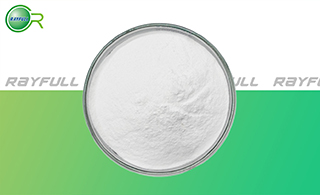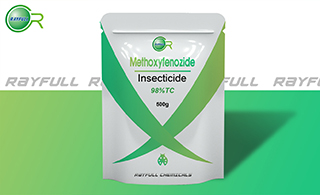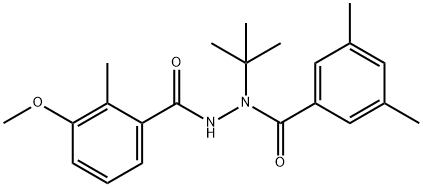Methoxyfenozide
    甲氧虫酰肼 甲氧虫酰肼
Introduction: Methoxyfenozide, a substituted dibenzoylhydrazine, is an insecticide that functions by accelerating the moulting process. It acts as an ecdysone agonist or ecdysonoid, substituting for the natural insect moulting hormone, 20-hydroxyecdysone. Methoxyfenozide is active on all feeding larval stages of the target Lepidoptera. It is used to control pests including codling moth, lesser apple worm, oriental fruit moth, leafrollers, cabbage looper, cotton bollworm, armyworm, and bud moths. It could be applied to leafy vegetables, fresh herbs, lettuce, salads, herbs, brassicas, cotton, pome fruit, grapes, sweetcorn, maize, peppers, and aubergines.
Common name: Methoxyfenozide
Another name: N'-(tert-Butyl)-N'-(3,5-dimethylbenzoyl)-3-methoxy-2- methylbenzohydrazide; Methoxyphenozide; Intrepid; N'-tert-Butyl-N'-(3,5- dimethylbenzoyl)-3-methoxy-2-methylbenzohydrazide; etc.
Chemical name: N-tert-butyl-N'-(3-methoxy-o-toluoyl)-3,5-xylohydrazide
Empirical formula: C22H28N2O3
Structural formula:

Mol. Weight: 368.47 g/mol
CAS No.: 161050-58-4
Specifications
Leading Methoxyfenozide supplier
Methoxyfenozide 98% TC
Methoxyfenozide 24% SC
Packing:
BULK PACKING
Powder: 25kg/Bag, 25kg/Drum, 50kg/Drum etc.
Liquid: 200L/Drum, 20L/Drum, 10L/Drum etc.
SMALL PACKING
Powder: 1kg/Alu bag, 500g/Alu bag, 200g/Alu bag, 100g/Alu bag, 50g/Alu bag, 15g/Alu bag etc.
Liquid: 5L/Drum, 1L/Bottle, 500ml/Bottle, 250ml/Bottle, 100ml/Bottle, 50ml/Bottle etc.
Customerized packing label
Methoxyfenozide FAO standard
Professional registration
HAZARDS IDENTIFICATION
Hazard statement(s)
H411: Toxic to aquatic life with long lasting effects.
Precautionary statement(s)
P501: Dispose of contents/container in accordance with applicable regulations.
Supplemental Hazard Statements:
EUH401: To avoid risks to human health and the environment, comply with the instructions for use.
EUH208: Contains: 1,2-benzisothiazolin-3-one. May produce an allergic reaction.
MAMMALIAN TOXICOLOGY
Acute toxicity: 1) Acute oral LD50 for rats is >5000 mg/kg. 2) Acute dermal LD50 for rats is >5000 mg/kg. 3) Acute inhalation toxicity LC50 (4 h) for rats is >4.3 mg/L. 4) Skin irritation: Non-irritating to skin (rabbits). 5) Eye irritation: Non-irritating to eyes (rabbits). 6) Skin sensitization for guinea pig: Non-sensitizer.
NOEL: (2 y) for mice is 4.3 mg/kg/day. Other Not carcinogenic.Not genotoxic.
ADI (JMPR) 0-0.1 mg/kg b.w. [2003]
Classification:
WHO Classification: U (Unlikely to present an acute hazard)
EC Risk Classification: N - Dangerous for the environment: R51/53
US EPA Classification (formulation): IV (Caution - Not acutely toxic)
ECOTOXICOLOGY
Effect on birds: Acute oral LD50 (8 d) for Bobwhite quail is >2250 mg/kg. Effect on fish: Acute LC50 (96 h) for Rainbow trout is >4.2 mg/l. Effects on aquatic invertebrates: Acute EC50 (48 h) for Daphnia magna is 3.7 mg/l. Effects on algae: Acute 72 hour EC50 for Pseudokirchneriella subcapitata is 3.4 mg/l. Effects on bees: Contact acute 48 hour LD50 is >100 μg/bee, oral acute 48 hour LD50 is >100 μg/bee. Effects on earthworms: Acute 14 day LC50 is >607 mg/kg.
ENVIRONMENTAL FATE
Animals Rapidly absorbed, metabolised via phase II conjugation and eliminated. Soil/Environment Photolytic DT50 in pond water 77 d. Soil photolysis DT50 173 d; aerobic soil metabolism DT50 336-1100 d (4 soil types); field DT50 23-268 d (10 studies).
Usage: Methoxyfenozide was developed by Dow AgroSciences. It is an insecticide used to control various insects including moths and butterflies.
Application: Biochemistry Second generation ecdysone agonist. Causes cessation of feeding and premature lethal moult. Mode of action Active primarily by ingestion, also with contact and ovicidal activity. Does not have translaminar or phloem-systemic properties. Uses Control of lepidopterous larvae, in vines, tree fruits, vegetables and row crops, at 20 - 300 g/ha.
| 






